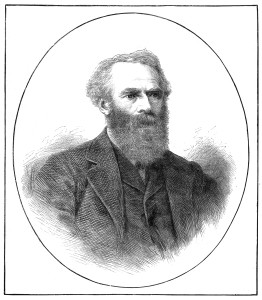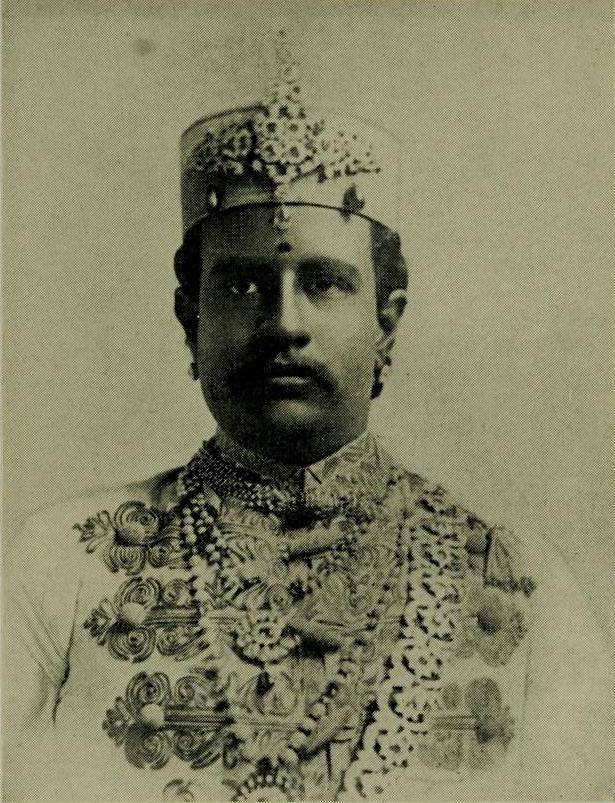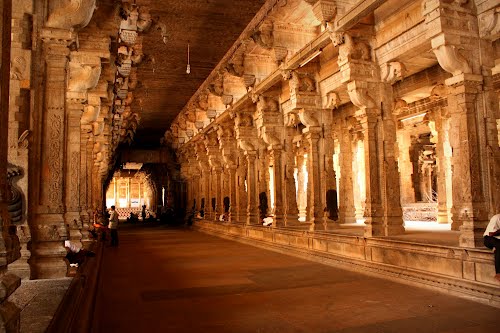Continuing the series on Hindu Temples, their conception, history, heritage and legacy authored by M.D. Srinivas.
Administering the temples through judiciary (1863-1925)
In 1841, the Governor of Madras, Elphinstone, had emphasised that the policy of withdrawal did not mean that the Government was giving up its “duty” of ensuring that the endowments were “protected from misuse and embezzlement.” He cited the communication from the London Court of Directors to explain the British policy on this issue:54

Sir Mount Stuart Elphinstone
The Court of Directors manifestly intend that ample protection shall be given to native religious institutions… for they declare that such protection is to be given through the medium of the Courts of Justice at the same time that they desire that that Pagoda Funds shall not be managed or appropriated by Government officers.
This was reiterated by the Government of India while laying down the policy withdrawal, cited above, when they declared that the management of native religious institutions “should be left to those best qualified and belonging to the same faith, and these officials together with their subordinates were to be responsible to the Court of Justice for any breach of duty or trust.” 55
While the policy was clear, it had still to be given effect through a new regulation replacing the Act VII of 1817. The Act XX of 1863, which came on the statute book on March 10, 1863, divided public religious endowments to two classes, which later came to be known as the “non-hereditary” and “hereditary” temples. In the case of the first
category of institutions the nomination of the trustees, managers and other administrators were vested in the Government. For the superintendence of these institutions, the Government were to appoint once and for all local committees of three or more persons (in each district) to take the place and exercise the power of the Board of Revenue under the earlier Act of 1817. Appointment to the local committees could be effected through election. After the committees had been formed the Board of Revenue and the local agents (collectors) were to transfer to them the properties of the endowments in their possession or under their supervision.
For the “hereditary temples”, the management and properties were to be left in the hands of the trustees or managers who, though free from the control of the local committees, were liable to be sued in the Courts by any person interested in them for any breach of trust or neglect of duty.
This brings us to the crucial second tier of control set up by Act XX of 1863, namely the jurisdiction of the Courts. Sections 14 and 15 of the Act stipulated:56
- Any person or persons interested in any mosque, temple or religious establishment, or in the performance of the worship or of the serviced thereof, may…sue before the Civil Court the trustee, manager or superintendent of such … religious establishment or the member of any committee …for misfeasance, breach of trust or neglect of duty…and the Civil Court may direct the specific performance of any act by such trustee, manager, superintendent or member of committee, and may also direct the removal of such trustee, manager, superintendent, or member of a committee.
- The interest required in order to entitle a person to sue under the last preceding section need not be a pecuniary, or a direct or immediate interest or such an interest as would entitle a person suing to take any part in the management or superintendence of trusts. Any person having the right of attendance, or having been in the habit of attending, at the performance of the worship or service at any mosque, temple or religious establishment, or of partaking in the benefits of any distribution of alms, shall be deemed to be a person interested within the meaning of the last preceding section.
So, to start with, any person “interested” in the religious establishment as per the above stipulation could initiate a suit. To make the Courts the central agency of the State for the control of religious institutions, a new Section, Section 539, was added into the Civil Procedure Code in 1877, under which the Attorney General, acting on his own initiative, was empowered to bring suit to “prevent mismanagement” in both hereditary and non-hereditary temples.
As one scholar has remarked:57
The most significant feature of Section 539 dealt with what were called temple “schemes”. A court was empowered to settle a “scheme of administration” on a temple if the Court deemed that no other short range remedy was possible.
This step had far reaching implications. A “scheme” typically prescribed the in detail the way in which a temple was to be administered. It could specify the respective duties and privileges of different temple functionaries, the use to which temple funds were to be put, and even the kinds of rituals to be conducted. The court was effectively in a position to chart a temple’s future development, economically administratively and religiously…there were few, if any limits, to judicial jurisdiction.
Section 539 was further revised into Sections 92 and 93 of the Civil Procedure Code in 1908. Incidentally it may be noted that the above Section was directly modelled on a particular portion of the English Charities Procedure Act of 1812, popularly known as Sir Romilly’s Act, which was meant to provide a summary remedy for mismanagement of English trusts.

Sri Bhaskara Setupati, the Raja of Ramanathapuram
As an illustration of the way “custom” and “tradition” were decided, fixed and enforced by the judiciary, we may consider the dispute between Sri Bhaskara Setupati, the Raja of Ramanathapuram, and the Nadar community in late nineteenth century in relation to the rights of worship at the Minakshi Sundareswarar Temple at Kamuthi. There was a dispute at that time between the Maravars and Nadars about their relative status, and consequently the Nadars were being denied honours at this temple managed by the Maravar community. After an incident in May 1898, when a group of Nadars “forcibly entered” the temple and demanded honours, the Raja as the “hereditary trustee” filed a case that disgrace had been brought both to the temple and its community of devotees. The further proceedings may be recounted as described in a recent study:58
The Judge in the original suit of 1898 was astute and methodical in elucidating most aspects of transactions in South India. But although he was puzzled that witnesses did not refer to the Nadars as polluting, he nowhere seems to have understood the place of temple-honours and the relationship of the Setupati to them in determining relations between communities. After amassing an impressive body of information, he determined that it was the custom in the Kanmuthi temple to exclude Nadars from worship. The case then went to the High Court, and subsequently to the Privy Council.
Of particular interest in light of the Judge’s determination that Nadars had customarily been excluded from the temple was an attempted compromise in the year 1901. The Nadars and Setupati announced their proposed agreement. The Setupati agreed to allow Nadars to worship in the temple, with one qualification.
They were to worship “in the same manner and to the same extent as the Vellala, Chetty and other Sudra sects of the Hindu community.”…
Having considered the joint proposals of the Nadars and the Setupati, the Judge concluded that it was unacceptable. The lower court judge had found that the prevailing custom at the Kamuthi temple had been to exclude Nadars from worship therein. In light of this custom therefore, the Setupati, according to the High Court Judge, did not have the power to enter into a compromise which would “alter the fundamental character and uses of the temple as ascertained by judicial authority.” Seven years after this proposal of compromise, the decision of the Judicial Committee of the Privy Council sustained the decision of both lower courts.
One scholar has summarised the developments during the period 1878-1925 as follows:59
The decisions of the Anglo-Indian judicial system in respect to the Hindu Temples after 1877 were guided by the…Act XX of 1863 and the Civil Procedure Code of 1877, 1882 and 1908. In the period between 1878 to 1925 an immense body of case law was generated all over India, which defined the scope of every clause of these sections, refined their applicability, explicated their interrelationship… [They] provided the framework as well as the impetus for a vast body of pan-Indian litigation in the period between 1878 and 1925, which provoked judicial codification of a large variety of rights, wrongs and rules concerning “public” aspect of conflicts in Indian temples…
He has also presented an incisive contrast between the management of the temples under the Hindu Kings and the system evolved by the British:60
Because the activities of the Indian kings in respect to temples were ‘administrative’ and not ‘legislative’ and because their resolutions were context specific and not absorbed into a general body of evolving case law, it is no surprise that a ‘law of endowments’ had not developed; instead, only an inscriptional record of specific instances of royal intervention and arbitration existed. But this seeming gap was rapidly filled by the British impulse to legislate and codify….…royal orders and judgements in respect of temples were not legislative, in so far as they were always addressed to specific groups and individuals, were not of general applicability, were subject to alteration or repeal according to the current needs of kingship, and could not fix the law or even strictly serve as illustration…
..unlike their Hindu predecessors who preferred to leave the day-to-day control of temples in local hands but did not hesitate to arbitrate of whatever sort, the British gradually expanded their day-to-day involvement in the temples, but grew increasingly reluctant to resolve temple disputes. The institutional separation, under British rule of ‘executive’ from ‘judiciary’ created ambiguities in the arbitration of temple disputes. Such ambiguities did not exist in the previous royal context…Given the contrast between the context-bound nature of Hindu royal orders made to resolve temple disputes and the generalising tendencies of the case law of the British courts (which grew immensely important after 1870), it is no surprise that the temple and the Anglo-Indian judiciary grew entangled in a growing cycle of interactions, which resolved little but provoked much new conflict.
Restoring bureaucratic control: The HRE Act (Act II of 1927)

Edwin Samuel Montagu was Secretary of State for India
The Government of India Act 1919 ( what is otherwise known as the Montegue-Chelmsford Reforms) provided for elected provincial councils, with jurisdiction over specified areas. Among the powers “transferred” to elected Indian representatives was the authority over religious endowments.
The Justice Party dominated Government in Madras with the Raja of Panagal as the Chief Minister, appointed a Committee in 1921 with Raja of Ramnad as the Chairman to draft a bill. At the instance of Sir Mohammed Habibullah the Muslim endowments (which had been included in the purview of the 1863 Act) were excluded from the scope of the contemplated bill.
When the issue of exclusion of the Mohammedan endowments was criticised by members who wondered whether the Government believed that the Mohammedan religious endowments were better managed than the Hindu ones, the Raja of Panagal replied that:62
I have no doubt that Honourable member will readily agree that the Khilafat question still disturbing the minds of the Islamic communities, the time is not quite suitable for undertaking legislation in regard to Mohammedan religious endowments.
As soon as the bill of 12 of 1922 was passed in 1923 and sent to the Governor for assent, several protests, memorials and presentations were addressed to the Governor asking him to withhold assent. A sammelana was organized by the Paramacharya Chandrasekhara Sarawati of Kachi Kamakotipeetham in Jambukeshwara in 1923, and another meeting of Dharmacharyas was held in Udupi. The Acharyas declared that the bill strongly violates the religious neutrality of the Government, guaranteed in the proclamation of queen Victoria in 1858 and reaffirmed in the Montegue-Chelmsford Report as also in the various statements of the British Viceroys. They pointed out that Mathams were not trusts, nor the Mathadhipatis trustees, and they should not be subject to any higher Government control than what exists in ordinary law and usage. They expressed their total disapproval of the new scheme of control of temples by a Board of paid commissioners and to the provisions which permit diversion of surplus funds towards secular objects such as education and similar purposes.63
During the debate in the Legislative Council in 1926, several features and clauses of the Bill were hotly debated. Many who had earlier supported an expanded state role in the administration of temples backed off, as they foresaw that the actual effect could be to further the Justice Party’s view of Hinduism.
Sri S. Satyamurti, the leading spokesman of the opposition Congress Party, vehemently criticised, what he referred to as the “extraordinary” provision of the bill vesting authority on the dhittams (or dittam – Anglo-Indian legalese for thittam or vyavastha, which in this context means the allocation made by the temple for daily worship and festivals) with the secular authority of the Board:64
This is the crux of my objection to this section. According to modern notions, to the committees and to the Board it will seem a wastage for instance to have a thousand plantains on the head of the deity or two thousand coconuts. But we believe that by offering these rich and varied offerings to the deities in the temples we are doing something meritorious. ..Are you going to vest in all these committees and the Board, without any test [of their faith] whatever, the right to determine the dhittam?
Opposing the provision of the bill empowering the Board to deploy “surplus income” of the temples, an authority which was so far vested in the Courts, based on the so called cy pres principle, Sri Satyamurty argued that the Board might well manipulate temple budgets to create artificial surpluses. But the main objection of Sri Satyamurthy was against the policy of Government control of religious institutions. He declared:65
…the complaint in this country is against over Government and against the initiative of the people and their capacity for local self-government being impaired. In this bill, even with regard to the most sacred right, we are asked to rely upon and look to the Government. The result will be…that just as the blighting hand of over Government has set upon our administration, the blighting hand of this Government will also fall tight on our temples and maths …
Sri Mayasaya, one of the bill’s most forceful opponents, tellingly referred to the difference between the Indian state in the former times and the Government of the day which sought to justify the provisions of the bill on the ground that kings in former times intervened in temple affairs:67
It has been said that the kings in the past interfered with the religious endowments and why then do you now object to the interference of the State as now constituted? The very constitution of the State will show the difference. Our kings in the olden days, the Hindu kings endowed properties for the temples and maths. They appointed trustees and constituted themselves as trustees. That is how they exercised their kingly duty of interfering with temple properties. But what is the case now? The Government which has got an ecclesiastical department for itself has nothing to do with the endowments of properties of the Hindus, yet wants to interfere with the religious institutions.
One interesting feature which emerged during the debate on the bill was that with such a draconian legislation of control coming into force, many communities and regions started making the claim that the temples of their area or community were not “Hindu” at all. A member from South Canara argued that the temples in his area were not “Hindu temples” but belonged to separate and independent “communities”. A representative from Malabar pointed out that in his area, perhaps with the exception of Palaghat, there were no villages, but only tarawads and the temples of tarawads were not public temples.68
Notwithstanding all this opposition, the Hindu Religious Endowments (HRE) bill was first passed as Act I of 1925 and later as Act II of 1927. The Act provided a machinery of supervision and administration, involving the Board of Commissioners, the Temple Committees and the Trustees and servants of the institutions. Under the Act, the religious institutions were divided into excepted temples, maths and non-excepted temples. The Board of Commissioners had direct jurisdiction over the excepted temples and maths and the Temple Committees exercised general superintendence over non-excepted temples.
To be continued in the next part of the series.
54 Letter of Elphinstone, dated 12.2.1841, in G.O. 210, Public 2.3.1841, cited from F.A. Pressler, Religion under Bureaucracy, Cambridge 1987, cited earlier, p.2
55 Tamil Nadu State Archives, Revenue Consultations, 15. 6.1841, p.4318.
56 cited from A.Appadurai, Worship and Conflict Under Colonial Rule, Cambridge 1981, p.170.
57 A. Pressler 1987, cited above, p.25-6.
58 Carol Appadurai Beckinridge, From Protector to Litigant – Changing Relations between Hindu Temples and the Raja of Ramanad, in South Indian temple: An Analytical Reconsideration, Ed. Burton Stein, New Delhi 1978, p.102-3.
59 Appadurai, 1981, cited earlier, p.175.
60 Appadurai, 1981, cited earlier, p.169-170, 214-5.
61 Notes on Letter 1892, L & M dated 18.10.1922, cited in C.Mudaliar, The State and Religious Endowments in Madras, Madras 1976, p. 65.
62 Proc. of Madras legislative Council, 19.12.1922, Vol.10, p.1006, cited from C.Mudaliar 1976, cited above, p.72.
Dr. M.D. Srinivas is Chairman of Centre Policy Studies, Member of the ICHR, Physicist, Sanskrit scholar, and author of numerous books including the widely-acclaimed Annam Bahukurvita and Indian Demographics.

